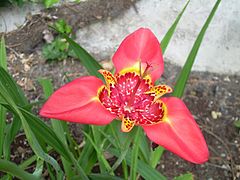| Tigridia pavonia | |
|---|---|
 | |
| A yellow-flowered form | |
| Scientific classification | |
| Kingdom: | Plantae |
| Clade: | Tracheophytes |
| Clade: | Angiosperms |
| Clade: | Monocots |
| Order: | Asparagales |
| Family: | Iridaceae |
| Genus: | Tigridia |
| Species: | T. pavonia |
| Binomial name | |
| Tigridia pavonia | |
| Synonyms [2] | |
List
| |
Tigridia pavonia is a species of flowering plant in the iris family Iridaceae. Common names include jockey's cap lily, [3] Mexican shellflower, [4] peacock flower, [4] tiger iris, [5] and tiger flower. [4] This summer-flowering bulbous herbaceous perennial is widespread across much of Mexico, Guatemala, El Salvador, and Honduras. It is naturalized in Ecuador and Peru. [4] [6]
The leaves are narrow and lance-shaped. The three-petalled blooms occur in a variety of colour combinations with strongly contrasting central markings. [7] The three sepals are larger, to three inches (7.5 cm) long, giving the flower a total width of six inches (15 cm). [8] They open early in the morning and close before dusk. Blooms are successional throughout summer. Plants bloom in the first year after sowing.[ citation needed ]
Tigridia pavonia is cultivated as an ornamental plant. It prefers a sheltered position in full sun, in sandy but fertile soil. The plants are said to be hardy to as low as −12 °C (10 °F) in many sources, [9] [10] [11] while in some others only to 5 °C (41 °F). [7] Most authorities recommend that the corms should be lifted and stored throughout the winter months in colder areas. [7] [11]
The roasted bulbs are edible and have been used by the American Indians and Indigenous peoples of Mexico. It has a chestnut-like flavour. [5]
The aphid Aphis newtoni may be found on this plant. [12]



